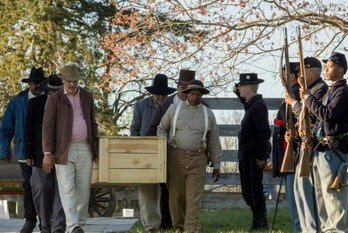During this battle, a cannon ball fired from a Union artillery piece punched through the walls of the Coleman home and wounded Hannah severely. After the ceasefire that announced what would be a lasting peace between the two armies, she was tended to by a Union army doctor at a field hospital set up behind the Coleman home.
Hannah did not survive her wound, which was described by the 8th Maine Volunteer Infantry’s Chaplain, J.E.M. Wright, as “a concave wound…corresponding to the size and shape of the ball.” Hannah was the only civilian casualty of battle and for many years, her story was a tale of a sad irony. The liberating army had arrived, but she had died just hours before the official surrender of the Confederate army made her free. Were that the end of the story, she would probably be confined to a footnote of history. However, in preparation for the April 2015 sesquicentennial of the battle and subsequent surrender, the National Park Service tasked local Appomattox Pastor Alfred L. Jones III with writing and delivering a eulogy for Hannah as part of its commemoration. The program, Footsteps to Freedom, celebrated the life of Hannah and the freedom granted by the Confederate army's surrender to the 4,600 Appomattox County slaves. In his research about Hannah, Jones came across a document that redefined Hannah’s life: a death registry. In it, Hannah Reynold’s death date is listed as April 12, 1865, not April 9 as was always assumed. The difference in those three days meant the difference between dying a slave hours short of liberation and dying a free woman. The importance did not appear to be lost on Dr. Coleman, who was listed in the register as the person who reported Hannah’s death. He listed himself as Hannah’s “former owner”. Hannah’s funeral, held April 11, 2015, featured Pastor Jones’ eulogy, a 100 member gospel choir and 4,600 luminaries—one for each slave in Appomattox County liberated by the surrender of the Army of Northern Virginia. Discussion Questions 1. What reasons could Hannah and Abram have had for staying in the Coleman home after their master left? Why do you think they didn’t take the opportunity to escape to the Union army lines? 2. What defines home to you? Would you risk your life to protect it? 3. If Hannah had been conscious, how do you think she may have responded to the idea of dying a free woman? 4. Is there an intrinsic value to freedom that transcends a person’s ability to take advantage of it? References and Further Reading Discovery Gives New Ending to a Death the Civil War's Close Funeral for a Former Slave Takes Center Stage at Appomattox 'Wounded as a Slave; Died as a Free Woman': Appomattox Anniversary Program to Honor Hannah Reynolds
0 Comments
Leave a Reply. |
AuthorToni is a wife, mom and history buff who loves bringing the Civil War to life for family members of all ages. Archives
July 2018
Categories
All
|

 RSS Feed
RSS Feed